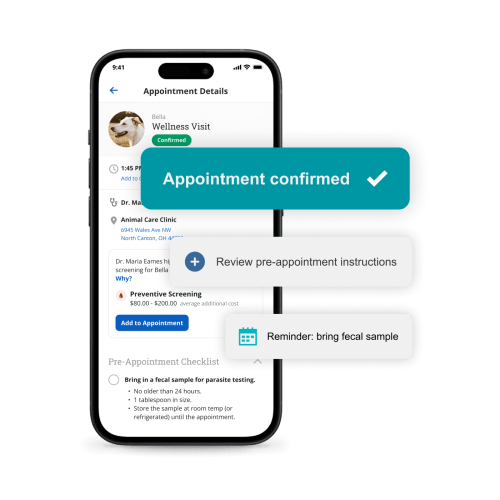Veterinary Exam Room Layout: Optimizing Space and Workflow

Human medical facilities dedicate entire floors and wings to various hospital departments, but a typical general veterinary practice must offer a wide array of services in a relatively small space. Therefore, they must optimize all spaces for multiple purposes and make the most of every square foot to improve overall practice efficiency.
Veterinary exam room layout can significantly impact workflow. Each room must contain essential equipment that is organized logically and also prioritizes client and patient comfort. Poor room layout can slow down visits, which can lead to longer wait times, frustrated clients, and stressed team members. Taking time to assess and optimize exam room layout and space can provide a better experience for clients, pets, and veterinary teams.
Facilitating easy access to tools and equipment
A logical veterinary exam room layout should minimize the need for movement inside and outside the room during visits. Once clients and pets have settled in the room, excessive activity can increase pet stress and disrupt appointment flow. Exam rooms must always be adequately stocked with consumables (e.g., needles, gauze, slides) and all the tools required for a complete physical examination and common in-office procedures. Placement also matters—place the most-used items in easy reach, using drawers, cabinets, wall-mounted dispensers, table-top organizers, and in-room refrigerators.
To determine an optimal veterinary exam room layout, ask the team members who spend the most time there—the veterinarians, technicians, and exam room assistants. Ask them to work together to name items and rank them from most to least used. Then, go through a mock exam and determine how to best place items, so the team member-client connection is not disrupted and the need for team members to turn their back to the client is minimal. Consider purchasing versatile rolling storage towers if storage items are awkwardly placed in relation to the exam room tables or client seating areas. Label each storage container with its contents and create stocking checklists to stay organized.
Designing spaces for comfort and convenience
Comfortable, quiet, and clean rooms are essential for making a good impression on clients and reducing patient stress. Avoid chairs with open spaces below, which pets tend to hide underneath. Instead, use a solid bench with a padded, easily cleaned seating surface, such as vinyl. Use non-slip mats, unscented cleaning products, non-fluorescent lighting, and soothing paint colors to create a calming, welcoming environment. Pets who feel more comfortable in an exam room are less stressed and more cooperative, which makes for a more efficient visit.
Optimizing foot traffic
Foot traffic in and around exam rooms can impact overall practice efficiency and workflows. Minimizing unnecessary foot traffic begins with waiting area and rooming protocols. Placing clients in exam rooms immediately on arrival is ideal for reducing stress and lobby crowding. Keeping rooms well-stocked prevents excessive trips in and out of exam rooms, and strategic workstation placement can prevent slowdowns when team members have to wait for a computer or phone or track one down in another hospital area.
The optimal veterinary exam room layout is influenced by hospital design and the floor plan. A popular design choice for improving efficiency and foot traffic flow is two entry points in each room—one for clients that leads to the lobby or exit and another for team members that leads to the treatment area. Hospitals without this feature should consider asking clients to wait in the car until a room is ready and should use online bill pay or in-room payments to reduce foot traffic around exam rooms.
Leveraging technology
An optimal veterinary exam room layout should be designed with practice technologies that will improve efficiency in mind. Mount computer workstations on walls in exam rooms, or provide team members with laptops or tablets to enter history information and exam findings directly into the medical record during visits. Some practices may include video monitors or interactive displays with educational materials to make the most of in-room waits.
Additionally, technology can streamline appointment scheduling and set up more efficient use of exam rooms. Online booking using compatible veterinary management software or client-facing applications can keep scheduling consistent and reduce errors, such as double-booking. The number of available exam rooms and typical appointment times should inform scheduling practices—for example, setting rules that limit the number of new patients or sick visits per hour.
A well-designed veterinary exam room layout promotes an efficient, low-stress workflow that benefits clients and teams. Ensuring intuitive access to necessary equipment and optimizing traffic can reduce client wait times and help veterinary teams serve more pets in less time, with fewer resources. Additionally, rooms designed with client comfort and convenience in mind can positively influence how clients view the practice and contribute to overall business loyalty and success.




